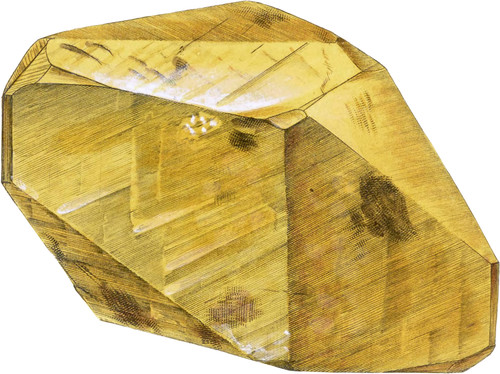 Enlarge
Enlarge
British Mineralogy
Metastatic crystallized Carbonate of Lime
- Div. 1. Crystallized.
This noble specimen of crystallized Carbonate, of Lime is curious, as a variety leading to a kind of Mackle that does not seem to have been suspected; but is not rare as to its formation, for we often see ordinary specimens that partake of it, having two of the opposite faces of each pyramid much widened, forming a base to each parallel to the edge of the primitive nucleus: this will be seen in the next figure, which may be compared with tab. 33, the usual Metastatic Mackle. The two facets, fig. 1, are primitive, and fig. 2 are the same as those of tab. 34, lower figure, equiaxed; but having those very obtuse-angled faces that so often produce a rounding form, which help so much in the numerous varieties of crystals in this substance, and are extremely curious. Fig. 3 is a somewhat rounded edge nearly on the angle of the pyramid. The facets, fig. 4, and that opposite, are of the hexaëdral column. Fig. 5, a facet nearly on the edge of the nucleus.
Tile rounded facets in Crystals are sometimes very deceiving; and the comparing this with the next plate will prove the necessity of this leading specimen, which shows the dividing angle of the natural face of the pyramids parallel with the primitive edge, that divides the two primitive facets at 1. 1. A little rounding face on the acute angles of the broader planes of the pyramid towards the facets of the prism, fig. 4, alters the parallelism of the edges, so that by turning round the two halves, as in the next figure, is formed the puzzling appearance so proper to be cleared up, on account of being totally new in Crystallography, and extremely curious.
This noble, beautiful, and singular Crystal is from Derbyshire, and is so suitable to precede the next figure, that I thought it quite proper to place it here, though indeed it is only the metastatic formation, as in tab. 35; but the breadth of two of the faces would disguise it to many, and more so if mackled as in the next figures, with the two faces still broader, and which this happily serves so clearly to elucidate, and, by the illinitions of the fractures, helps to point out the mutual base of the mackling parts; which is, I believe, both new and extraordinary, as it coincides with a plane drawn through the longer diagonal of the primitive rhomb.
Its colour seems clearly to depend upon the Oxide of Iron, which is partly mixed and partly chemically combined.

